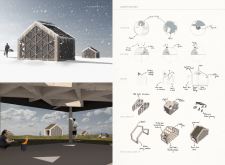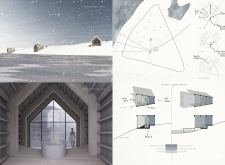5 key facts about this project
At its core, the project represents a fusion of innovative design principles and traditional architectural elements. The primary function of the building is to provide a versatile space that can accommodate a variety of activities, fostering both social interaction and individual reflection. This duality is especially important in the contemporary context where spaces are often expected to adapt to the ever-changing needs of their users.
The architectural composition consists of several key components, each contributing to the overall harmony of the design. Large, strategically placed windows facilitate natural light penetration, creating an inviting atmosphere that blurs the line between the interior and exterior environments. This connection to nature not only enhances the aesthetic appeal of the space but also supports well-being and sustainability initiatives through passive heating and cooling.
Materiality is another crucial aspect of this architectural project. A thoughtful selection of materials such as reinforced concrete, timber, and glass was employed to promote durability while also providing visual warmth and texture. Concrete lends structural integrity and a sense of permanence, whereas timber brings an element of warmth and natural beauty. Glass, utilized in expansive façades, allows for an abundance of light and promotes energy efficiency through modern glazing techniques. This combination of materials is not only practical but also aligns with the project's commitment to sustainability, balancing ecological concerns with aesthetic values.
The design incorporates unique approaches to conventional spaces. For example, communal areas are designed with flexible configurations that can adapt to various gatherings or activities, emphasizing interaction among users. In contrast, private spaces maintain a peaceful atmosphere, thoughtfully insulated from the noise of communal areas. These variations in spatial organization reflect the designers' awareness of diverse user needs and their intention to foster community engagement while respecting individual privacy.
Landscaping also plays an integral role in the project, enhancing the overall experience and promoting a sense of place. Thoughtfully placed greenery and outdoor areas encourage users to engage with nature, complementing the interior environment through visual continuity. The integration of native vegetation not only harmonizes with the local ecosystem but also minimizes maintenance demands and promotes biodiversity.
In evaluating the overall design, it is important to recognize the significance of context. The project’s location has influenced many design decisions, from the orientation of the building to the selection of materials that resonate with the regional climate. This mindful consideration of the surroundings ties the architecture into its community, allowing it to grow organically within its setting.
As a comprehensive project rich in detail and thoughtfulness, this architectural design stands out through its dedication to functionality, sustainability, and user experience. It invites readers and potential users to explore the architectural plans, sections, and ideas that shaped every aspect of the design. For those interested in delving deeper, a careful examination of the architectural designs will provide further insights into the thoughtful choices made throughout the project's development. Embracing the practicality of modern living while honoring the nuances of its environment, this project becomes not just a building, but an integral part of the community fabric.


























